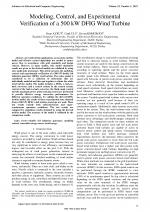| 1/2022 - 2 |
Modeling, Control, and Experimental Verification of a 500 kW DFIG Wind TurbineAYKUT, O., ULU, C. |
| Extra paper information in |
| Click to see author's profile in |
| Download PDF |
Author keywords
doubly fed induction generator, modeling control, renewable energy source, wind energy
References keywords
wind(36), power(21), control(21), energy(19), induction(14), doubly(14), generator(12), system(11), turbines(10), turbine(8)
Blue keywords are present in both the references section and the paper title.
About this article
Date of Publication: 2022-02-28
Volume 22, Issue 1, Year 2022, On page(s): 13 - 20
ISSN: 1582-7445, e-ISSN: 1844-7600
Digital Object Identifier: 10.4316/AECE.2022.01002
Web of Science Accession Number: 000762769600003
SCOPUS ID: 85126826344
Abstract
In wind turbine applications, an accurate turbine model and effective control algorithms are needed to ensure power flow in accordance with grid standards and design criteria. However, in many studies, only model simulation results are given or the derived models are validated by using only small-scale prototypes. This article presents the modeling, control, and experimental verification of a 500kW doubly fed induction generator (DFIG) wind turbine. The entire model is considered to be a collection of subsystems that are individually modeled and then put together to obtain the whole wind turbine model. The model includes a DFIG, a back-to-back converter, and a control system. In the control system, control of the back-to-back converter, the blade angle control and the maximum power point tracking control are performed to provide effective energy conversion performances for different operation conditions. To validate the derived DFIG turbine model, the results of three experimental tests obtained from a 500kW DFIG wind turbine prototype are used. These test results include both subsynchronous and super-synchronous operation conditions. The test results are compared to simulation results obtained by using the derived turbine model. The accuracy of the model is validated by the comparison results. |
| References | | | Cited By |
Web of Science® Times Cited: 4 [View]
View record in Web of Science® [View]
View Related Records® [View]
Updated 3 weeks, 5 days ago
SCOPUS® Times Cited: 5
View record in SCOPUS® [Free preview]
View citations in SCOPUS® [Free preview]
[1] Analysis of Doubly Fed Induction Generator-based wind turbine system for fault ride through capability investigations, Tuka, Milkias Berhanu, Endale, Salem Molla, Wind Engineering, ISSN 0309-524X, Issue 6, Volume 47, 2023.
Digital Object Identifier: 10.1177/0309524X231186762 [CrossRef]
[2] Application of Backstepping Control With Nonsingular Terminal Sliding Mode Surface Technique to Improve the Robustness of Stator Power Control of Asynchronous Generator-Based Multi-Rotor Wind Turbine System, Yahdou, Adil, Benbouhenni, Habib, Colak, Ilhami, Bizon, Nicu, Electric Power Components and Systems, ISSN 1532-5008, 2024.
Digital Object Identifier: 10.1080/15325008.2024.2304688 [CrossRef]
[3] Design of cascade control loops for DFIG based wind energy conversion system control, Sreenivasulu, Panisetty, Hussain, Jakeer, Matéria (Rio de Janeiro), ISSN 1517-7076, Issue , 2025.
Digital Object Identifier: 10.1590/1517-7076-rmat-2024-0962 [CrossRef]
[4] Fractional-order neural control of a DFIG supplied by a two-level PWM inverter for dual-rotor wind turbine system, Benbouhenni, Habib, Colak, Ilhami, Bizon, Nicu, Abdelkarim, Emad, Measurement and Control, ISSN 0020-2940, Issue 3, Volume 57, 2024.
Digital Object Identifier: 10.1177/00202940231201375 [CrossRef]
Disclaimer: All information displayed above was retrieved by using remote connections to respective databases. For the best user experience, we update all data by using background processes, and use caches in order to reduce the load on the servers we retrieve the information from. As we have no control on the availability of the database servers and sometimes the Internet connectivity may be affected, we do not guarantee the information is correct or complete. For the most accurate data, please always consult the database sites directly. Some external links require authentication or an institutional subscription.
Web of Science® is a registered trademark of Clarivate Analytics, Scopus® is a registered trademark of Elsevier B.V., other product names, company names, brand names, trademarks and logos are the property of their respective owners.
Faculty of Electrical Engineering and Computer Science
Stefan cel Mare University of Suceava, Romania
All rights reserved: Advances in Electrical and Computer Engineering is a registered trademark of the Stefan cel Mare University of Suceava. No part of this publication may be reproduced, stored in a retrieval system, photocopied, recorded or archived, without the written permission from the Editor. When authors submit their papers for publication, they agree that the copyright for their article be transferred to the Faculty of Electrical Engineering and Computer Science, Stefan cel Mare University of Suceava, Romania, if and only if the articles are accepted for publication. The copyright covers the exclusive rights to reproduce and distribute the article, including reprints and translations.
Permission for other use: The copyright owner's consent does not extend to copying for general distribution, for promotion, for creating new works, or for resale. Specific written permission must be obtained from the Editor for such copying. Direct linking to files hosted on this website is strictly prohibited.
Disclaimer: Whilst every effort is made by the publishers and editorial board to see that no inaccurate or misleading data, opinions or statements appear in this journal, they wish to make it clear that all information and opinions formulated in the articles, as well as linguistic accuracy, are the sole responsibility of the author.



